When it comes to placing your outdoor miniature bonsai tree, think sun, humidity, and protection! Aim for 4-6 hours of direct sun daily, especially for those sun-loving Junipers. Don’t forget about humidity; a humidity tray can be your best friend! Keep an eye on temperature—tropicals can’t handle cool drafts. Wrap those roots in mulch like a cozy blanket in winter! Isn’t bonsai care a delightful dance? Stick around, and we’ll explore more bonsai wisdom together!
Quick Takeaways
- Ensure your miniature bonsai receives 4-6 hours of direct sunlight daily for optimal health and growth.
- Maintain humidity levels between 40-50% using humidity trays and regular misting, adjusting for tropical species as needed.
- Protect bonsai during winter by covering roots with organic mulch and partially burying pots for insulation.
- Monitor temperature closely, keeping temperate bonsai above 25°F and tropical bonsai indoors if temperatures drop below 60°F.
- Choose an appropriate soil mix for your bonsai, emphasizing good drainage while retaining moisture for healthy root development.
Ideal Sunlight Exposure for Bonsai Trees
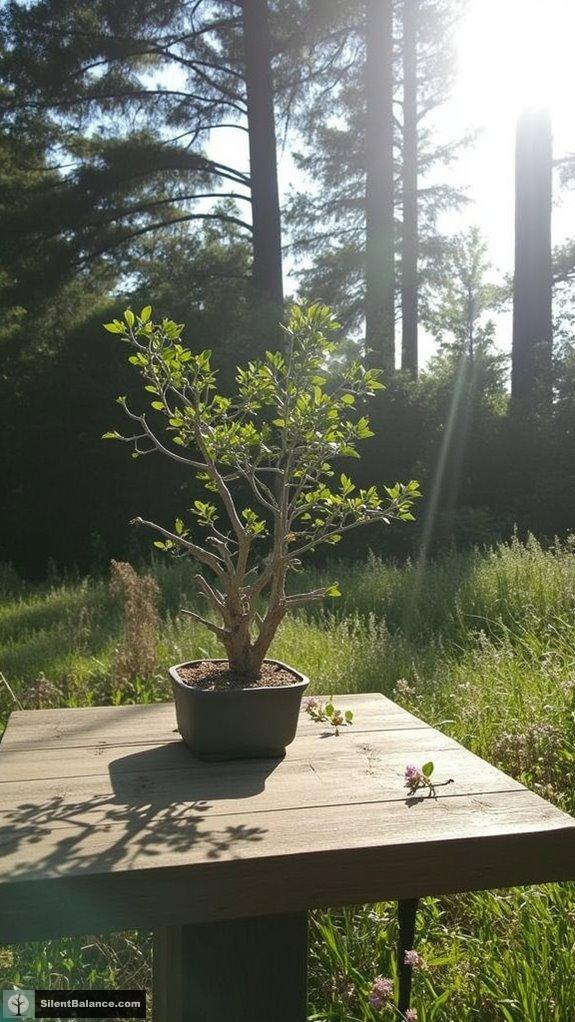
When it comes to giving your bonsai the love it deserves, you can’t underestimate the power of sunlight.
Think of it as the special ingredient in your bonsai’s growth recipe. Most outdoor bonsai need at least 4-6 hours of direct sun daily, but if you’re nurturing a juniper, aim for a sun-soaked 12-15 hours. Additionally, adequate light exposure during the growing season enhances their resilience against pests and diseases.
Why? Well, sunlight fuels their photosynthesis party, helping those little leaves and internodes develop beautifully. Additionally, providing the correct sun exposure is vital for sustaining your bonsai’s health.
Enhancing Humidity and Air Circulation
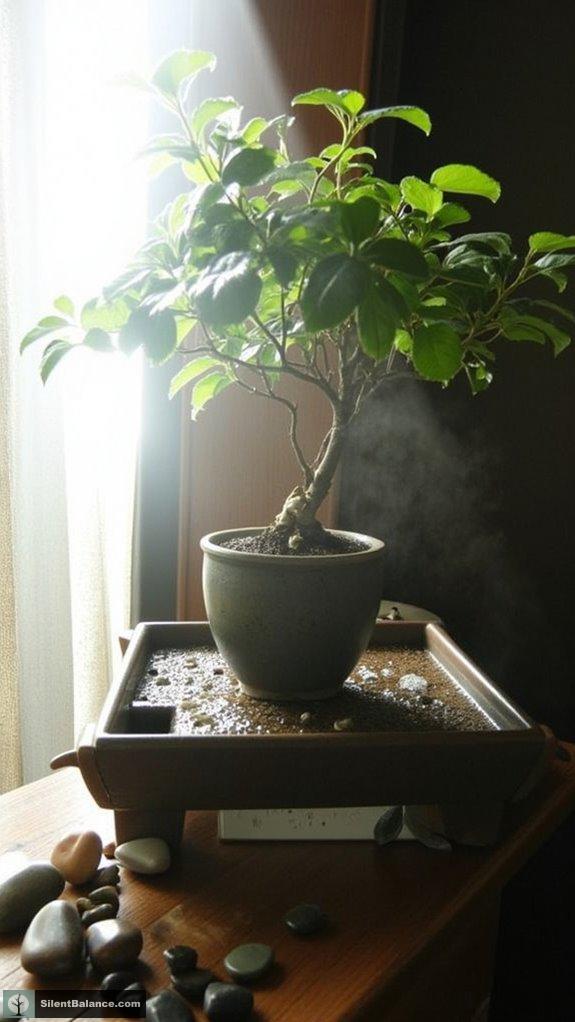
To truly flourish, your miniature bonsai needs more than just sunlight; it craves a humid, breezy haven to thrive.
For most of my bonsai buddies, maintaining an ideal humidity of 40% to 50% is key—tropical species, however, love the humidity cranked up to 70%. In winter, protecting your bonsai from harsh temperatures is equally important to ensure their well-being.
I place humidity trays filled with water beneath their pots, allowing gentle evaporation to boost moisture without saturating the roots. Misting their foliage several times a day? Yup, it’s essential, especially in those dry spells. Maintaining humidity with a hygrometer can be very beneficial to ensure your bonsai thrives.
Don’t forget to position your bonsai where a soft breeze can dance around the leaves but shield it from harsh winds.
After all, wouldn’t you want your bonsai to feel pampered and refreshed, not stressed and soggy?
Temperature Management and Seasonal Adaptation
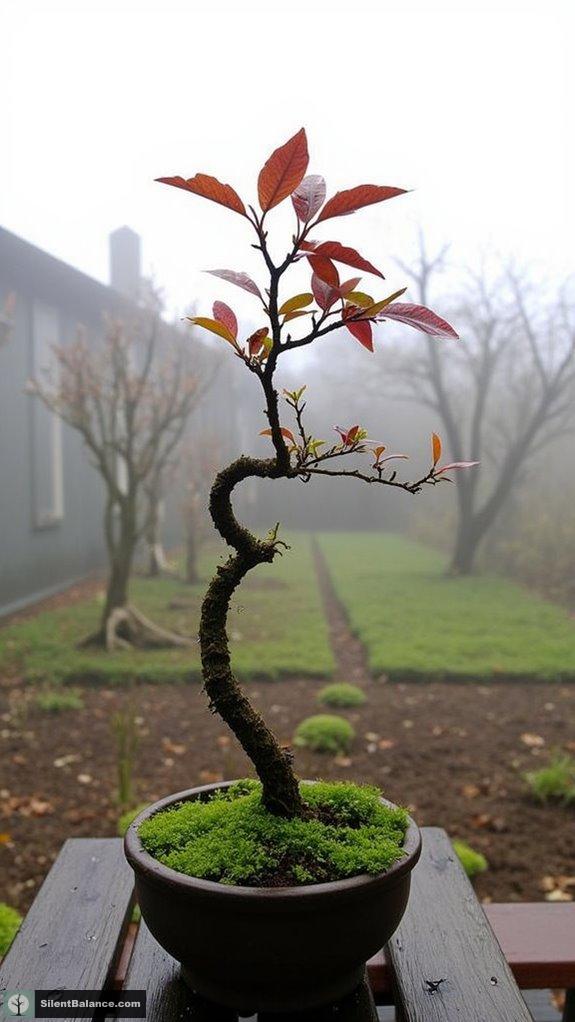
Temperature management and seasonal adaptation are essential when nurturing your miniature bonsai, especially if you want your little tree to thrive through the changing weather like a pro.
Did you know that temperate bonsai can handle winter chills down to 15°F? Just keep them cozy above 25°F. Conversely, tropical varieties need a warm hug, indoors when it’s below 60°F.
Keep in mind, abrupt temperature changes are like a bad surprise party, breaking dormancy and inviting frostbite.
When colder months roll in, think of good ol’ hibernation—place those bonsai closer to the ground to shield them from harsh winds and sudden drops.
Protection From Environmental Stressors
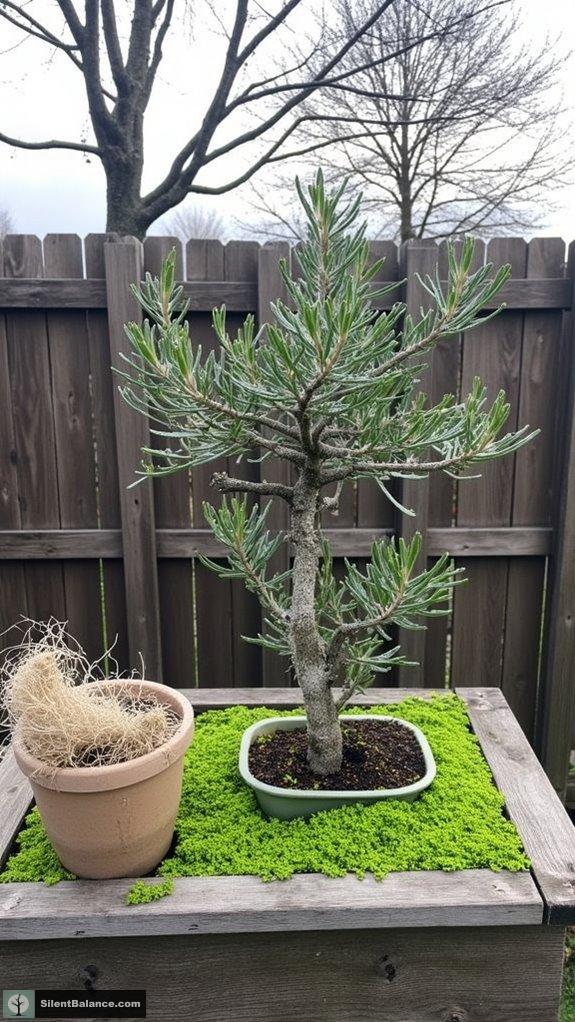
As the seasons shift and the temperature dips, it’s time to give some serious thought to keeping our beloved bonsai safe from all those lurking environmental stressors.
First up, let’s talk frost. Covering roots with organic mulch acts like a cozy blanket, and burying pots partially in the ground? Genius for winter insulation! Don’t forget to wrap those fragile ceramic pots in burlap to guard against cracking.
Now, strong winds can be a bonsai’s worst enemy. Position your tree near a fence or wall—think of it as building a protective fortress.
And don’t hide it in dark corners; sunlight makes for vibrant growth!
Keeping an eye out for leaf browning or branch breakage helps you stay ahead of potential disasters. Isn’t caring for bonsai like raising a mischievous child?
Considerations for Soil and Drainage
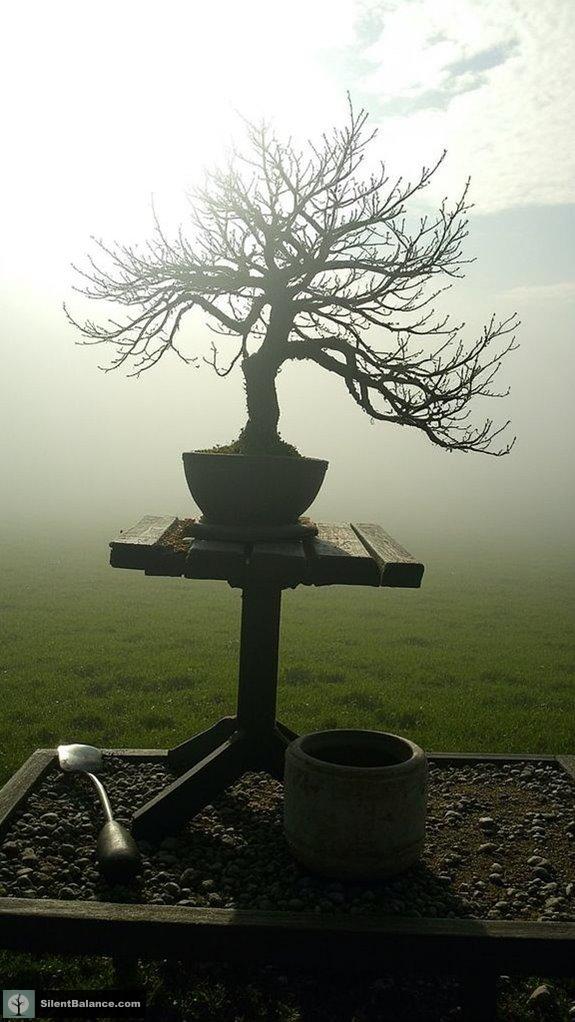
Getting the soil right is like finding the perfect pair of shoes; if you want your bonsai to thrive, it’s crucial to strike that balance between moisture retention and drainage.
Trust me, you don’t want waterlogged roots—root rot is no fun!
I usually go for a mix of 50% Akadama, 25% Pumice, and 25% Lava rock for my deciduous beauties. It’s like giving them a nutrient-rich spa treatment.
And don’t forget about particle size; keeping it between 2 mm and 6 mm guarantees they breathe easy.
Have you considered your climate? Adjust your soil mix accordingly. More Akadama for drier areas, and more lava rock in the soggier spots. Your little tree buddies will thank you for it!
Bonsai Tree Symbolism
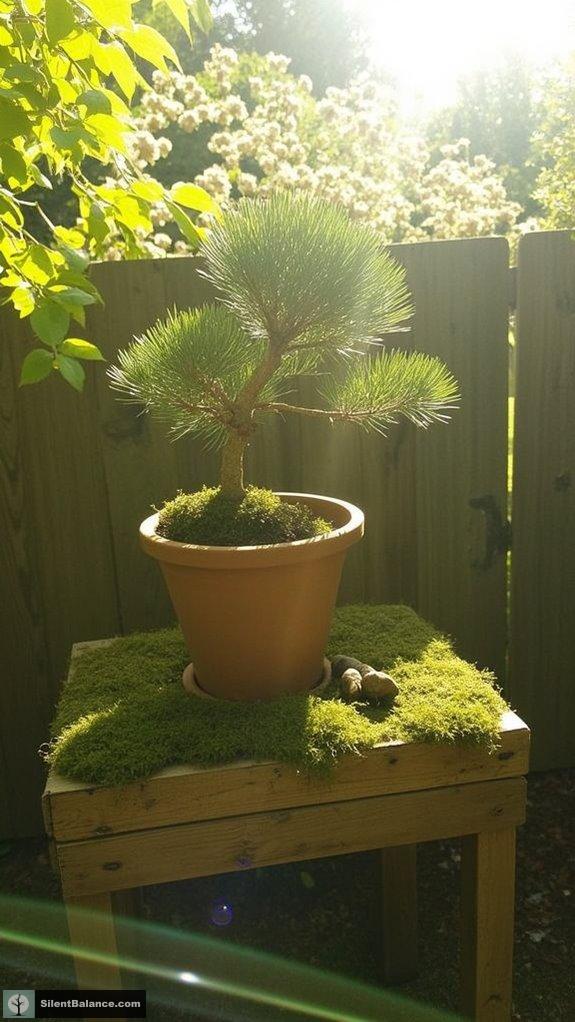
The art of bonsai isn’t just about pruning and potting; it’s steeped in rich symbolism that speaks to the core of life itself.
Bonsai trees, with their miniature settings, remind us of harmony, patience, and resilience. Each species conveys unique emotions, making them heartfelt gifts.
Here’s a quick glimpse into bonsai symbolism:
| Symbolism | Meaning | Species Example |
|---|---|---|
| Harmony | Balance in life | Juniper Bonsai |
| Peace | Promotes relaxation | Azalea Bonsai |
| Resilience | Thriving in constraints | Ficus Bonsai |
| Love | Gentle beauty and abundance | Cherry Blossom Bonsai |
Tree Symbolism
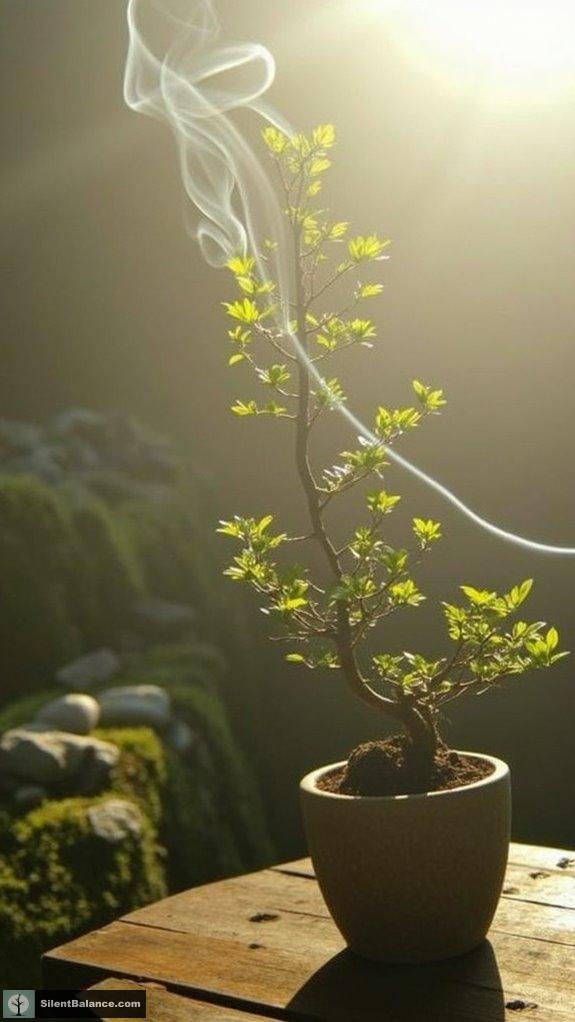
Tree symbolism weaves an enchanting tapestry, connecting us to nature’s essence in mesmerizing ways.
When I nurture my bonsai, I feel as if I’m holding a piece of the universe in my hands.
Did you know each tree tells a story? Bonsai represent wisdom, resilience, and harmony. Their miniature forms embody patience, often requiring years to shape.
I love how the winds of change whisper through their leaves, reminding me that growth doesn’t happen overnight. Isn’t that beautiful?
Plus, when we care for these trees, we’re not just tending to plants; we’re cultivating our own souls, too.
Questions and Answers
How Often Should I Water My Outdoor Bonsai Tree?
When I care for my outdoor bonsai tree, I check the soil daily, especially in hot weather. It sometimes needs watering every day, but I adjust based on moisture and climate changes to keep it healthy.
Can Bonsai Trees Survive Winter Outdoors?
Think of bonsai trees as delicate dancers, gracefully enduring winter’s chill. I’ve learned they can survive outdoors, but ensuring they curl up in cozy spots away from frost is essential to keep them thriving.
What Type of Soil Is Best for Bonsai Trees?
I believe the best soil for bonsai trees combines akadama, pumice, and lava rock. This mix keeps their roots happy with proper moisture and aeration. Trust me; healthy soil’s essential for thriving bonsai!
How Do I Prune My Bonsai for Optimal Growth?
Pruning my bonsai is like sculpting a whispering tree; each cut reveals its soul. I focus on balance and shape, nurturing its spirit while ensuring it thrives. Let’s begin this journey together, cultivating beauty in every snip.
What Pests Should I Watch for With Outdoor Bonsai?
When caring for my outdoor bonsai, I keep an eye out for aphids, spider mites, and vine weevil larvae. Regular inspections help me catch these pests early, ensuring my precious trees stay healthy and vibrant.
References
- https://hookedonbonsai.com/how-to-grow-and-care-for-an-outdoor-bonsai-tree/
- https://www.ftd.com/blog/bonsai-tree-care
- https://abanahomes.com/blogs/news/how-to-pick-the-right-position-for-your-bonsai-to-grow
- https://www.bonsaiempire.com/basics/bonsai-care/position
- https://brusselsbonsai.com/recommended-care/
- https://www.sungreenbonsai.com/post/understanding-bonsai-tree-sunlight-requirements-essential-tips-for-healthy-growth
- https://bonsai2u.co.uk/how-much-sun-does-a-bonsai-tree-need/
- https://www.bonsaibaime.com/bonsai-tree-after-care
- https://www.bonsaiempire.com/tree-species/outdoor-bonsai
- https://plantcitybonsai.com/bonsai-care
- https://www.herbs2000.com/flowers/b_air.htm
- https://bonsaiandbrewstudio.com/blogs/news/bonsai-temp-humidity
- https://bonsaiwest.com/resources/bonsai-care/
- https://www.bonsaiempire.com/basics/bonsai-care/overwintering
- https://www.kaizenbonsai.com/pages/guide-to-overwintering-outdoor-bonsai
- https://www.bonsainut.com/threads/temperatures-and-tropicals.24765/
- https://www.backyardboss.net/overwintering-bonsai-trees/
- https://www.bonsaiboy.com/catalog/outdoorbonsaicare.html
- https://www.bonsaiempire.com/blog/bonsai-soil-requirements
- https://www.bonsaiempire.com/basics/bonsai-care/bonsai-soil
- Unique Bonsai Pots for Zen Home Decor - September 6, 2025
- 7 Essential Tips for Selecting Outdoor Bonsai Tree Containers - September 6, 2025
- Perfect Pots for Thriving Tropical Bonsai Tree Containers - September 5, 2025

